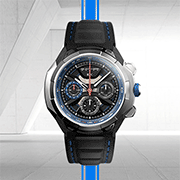Chassis No. WP0ZZZ99ZKS199175 935 Limitation No. 75/77 Born in the late 1970s out of the FIA Group 5’s liberal “silhouette” rules, the Porsche 935 is the car many motorsport fans immediately picture when thinking of that mad, flame‑throwing, wide‑flared era of competition. Introduced for the 1976 season, the FIA launched the Group 5 “Special Production Car” category—a formula that required only the production hood, roof, doors, and chassis rails to remain unaltered. Teams quickly grafted on sweeping fender flares and extravagant wings wherever possible, but none were better at exploiting these rules than Porsche. Discovering that the regulations said nothing about headlamp housings or heights, Porsche engineers replaced the stock units with a streamlined “flatnose,” which would become the 935’s signature. By 1978, in its ultimate factory-developed form—the 935/78—the twin-turbocharged flat-six had grown to 3.2 liters and was producing up to 862 PS, enabling trap speeds of 366 km/h on the Mulsanne Straight at Le Mans. These outrageous figures, combined with the car’s enlarged, long-tail bodywork and white Martini livery, earned it the fearsome nickname “Moby Dick.” The 935 proved almost unstoppable in endurance racing. Variants of Porsche’s Group 5 monster scored overall wins at premier circuits across the globe—including six victories at the 24 Hours of Daytona and 12 Hours of Sebring, and a trio of 1,000-km Nürburgring wins. Most notably, the Kremer Racing 935 K3—a privateer‑developed evolution of Porsche’s 935 homologation special—claimed overall victory at the 1979 24 Hours of Le Mans, the first production-based car to do so since the Ford GT40 over a decade prior. Fast forward forty years, and Porsche Motorsport undertook a secret skunkworks project code-named “Project Flatnose.” The result, unveiled to stunned onlookers at Rennsport Reunion VI in September 2018 at Laguna Seca, was a modern track-only 2019 Porsche 935—a limited-edition clubsport machine honoring the Group 5 racer. The venue and timing were fitting, as Porsche was marking its own 70th anniversary in 2018, and it had been 40 years since the original “Moby Dick” 935/78 had debuted. The new 935’s dramatic 4.87-meter-long bodywork immediately evoked its predecessor. Painted in a heritage Martini livery for the launch, it featured an extended tail section and huge rear fender fairings that unmistakably paid tribute to the original 935’s hallmark features. Project lead and veteran Porsche designer Grant Larsen remarked fondly, “This project was special because of all the freedom we had. There wasn’t going to be any homologation, so both we and the engineers were free to design as we wished.” Every element of the design was thus steeped in Porsche Motorsport heritage. For example, the prominent vertical LED taillights mounted in the wing endplates were borrowed directly from the Le Mans-winning Porsche 919 Hybrid LMP1 prototype. The side mirrors were the same units used on the factory 911 RSR GTE race car that won its class at Le Mans. Out back, the 935’s dual “cookie-cutter” exhaust pointedly echoed the look of the 904/906/908 endurance racers’ pipes from the 1960s. Every angle of the car offers something nostalgic— fan-style wheel covers, riveted fairings, and that gigantic wing harken back to Porsche’s endurance monsters of the 1970s and ’80s. These references are carried inside the spartan cockpit, where the PDK shifter was topped with a laminated wooden knob, an homage to the beechwood shift knob of the immortal Porsche 917 and other Porsche endurance legends. The driver gripped a quick-release carbon-fiber steering wheel shared with the 2019 911 GT3 R race car and faced a modern Cosworth digital instrument cluster. Other motorsport-grade appointments included a full FIA-spec roll cage integrated into the structure, a single racing bucket seat as standard, a 115-liter FT3 fuel cell with an external filler, and an electric fire-suppression system. Surprisingly, standard air conditioning was also fitted as a welcome amenity during hot lapping sessions. Underlying its exaggerated carbon fiber bodywork was the vaunted chassis and powertrain from the 991.2-generation 911 GT2 RS Clubsport, Porsche’s factory-built track variant of the GT2 RS. Its 3.8-liter twin-turbocharged flat-six (Type MA173) with water-cooled heads and dry-sump lubrication, produced 700 PS at 7,000 rpm and 750 Nm of torque. Power was transmitted to the rear wheels via a seven-speed PDK dual-clutch transaxle and an electronically controlled limited-slip differential, propelling the 1,380-kilogram clubsport machine to 100 km/h in just 2.7 seconds, on its way to an estimated top speed of 330 km/h. Massive racing brakes—380-mm front discs with six-piston Brembo calipers and 355-mm rears with four-piston units—combined with fully adjustable race suspension and Michelin Pilot Sport GT slick tires to deliver what Car and Driver described as handling with "so much grip that you'll bruise your ribs against their one-piece Recaro racing seats," backed by brakes that "feel as if they could stop a commercial airliner." This ultra exclusive, so-called “birthday present from Porsche Motorsport to fans all over the world,” was limited to just 77 examples and reserved for Porsche’s most valued motorsport clients. Intended for “clubsport events and private training on racetracks,” three of the 77 cars nonetheless contested a special GT2 Supersportscar Weekend race at Spa-Francorchamps in 2019. There, longtime Porsche privateer Egidio Perfetti piloted his 935 to victory in both sprint races that weekend. In 2020, a 935 took on the legendary Pikes Peak International Hill Climb (PPIHC). The Ingram Collection 935, driven by seven-time PPIHC division winner, filmmaker, and Air|Water co-founder Jeff Zwart, stole the show in the Time Attack 1 class by finishing just seven seconds behind David Donner on the demanding 12.5-mile mountain course. Offered here is limitation number 75 of the 77 Porsche 935s built, chassis WP0ZZZ99ZKS199175, presenting in virtually new condition with only delivery mileage. Like all 77 examples, the car was completed by Stuttgart-Zuffenhausen with its exterior in Achatgrau (Agate Grey), and was delivered to its first and only owner. In May 2019, Porsche announced a selection of seven custom liveries which could be optioned to adorn the 935’s carbon fiber skin, including tributes to legendary racing teams such as the Gulf blue of John Wyer's team, the turquoise Vaillant design from Kremer Racing, and the red Salzburg Team colors, among others. Notably, the example offered here showcases a livery outside of those of the official seven—it is finished in “Piper Green,” a striking bright-green with white accents. This color scheme is a bespoke homage to British privateer David Piper, who famously painted many of his race cars in a similar green tone with white stripes. Piper campaigned various top-level Porsches and Ferraris in the 1960s and 1970s, including his own Porsche 917 K (chassis 917-010) which was presented in his signature green-and-white livery. By opting for Piper Green, the original owner of this 935 alluded to Porsche’s privateer racing heritage, combining the mystique of Piper’s 917 with the extreme shape of the modern Moby Dick. Whether showcased at premier circuit events such as future Rennsport Reunions or run flat-out on exclusive track days, this uncompromising track-only machine promises to deliver the visceral performance and visual drama that made its Group 5 predecessor so iconic. Complete with its factory tool set, limitation number 75 of 77 represents an opportunity to own a remarkable tribute to one of Porsche’s most recognizable racing machines, ready to take its place among the world's most coveted track cars or serve as the centerpiece of a distinguished Porsche collection.
- Fuel
- Body Types
- Transmission
- Exterior Colour
- Number of doors
- Interior Colour
- VIN CodeWP0ZZZ99ZKS199175














































































































































































































